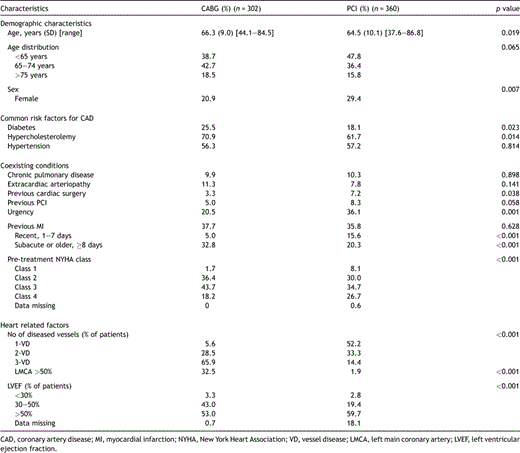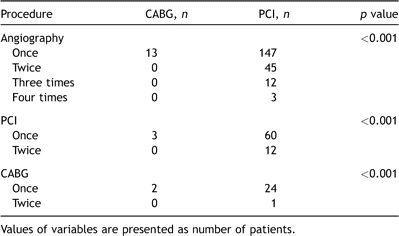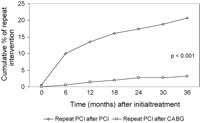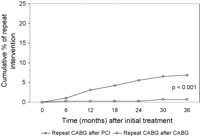-
PDF
- Split View
-
Views
-
Cite
Cite
Pertti Loponen, Kari Korpilahti, Michael Luther, Heini Huhtala, Matti R. Tarkka, Repeat intervention after invasive treatment of coronary arteries, European Journal of Cardio-Thoracic Surgery, Volume 35, Issue 1, January 2009, Pages 43–47, https://doi.org/10.1016/j.ejcts.2008.08.024
Close - Share Icon Share
Abstract
Objective: Patients who undergo successful revascularisation either with coronary artery bypass grafting (CABG) or with percutaneous coronary intervention (PCI) may subsequently require repeat invasive procedures. Methods: A cohort of 662 coronary artery diseased (CAD) patients was retrospectively reviewed. Follow-up was 36 months. Results: Thirty-day mortality was 1.0% in the CABG group (n = 302) and 0% in the PCI group (n = 360) (p = 0.094). Overall 3-year survival for the cohort was 95.0% (NS). In addition to repeat angiographies (cumulative frequency 57.7% for PCI vs 4.3% for CABG, p ≪ 0.001) patients underwent both repeat PCI (20.7% vs 3.2%, p ≪ 0.001) and repeat CABG (6.9% vs 0.7%, p ≪ 0.001) during the follow-up. In Cox regression analysis hazard ratio (HR) for repeat PCI after initial PCI was 8.5, 95% confidence interval (CI) 3.7–19.5, p ≪ 0.001 and for repeat CABG 9.5, CI 2.2–40.0, p = 0.002 in comparison to initial CABG. In-stent restenosis and progression of atherosclerotic plaques in native vessels were reasons for repeat intervention among the PCI patients. Complications with bypass grafts together with progression of the underlying disease were factors for re-interventions after CABG. Conclusions: PCI is far less invasive and may have lower in-hospital mortality rates than CABG. However, the highly likely need for repeat invasive procedures and revascularisation has to be taken into consideration when choosing an invasive approach for multi vessel CAD patients.
1 Introduction
Coronary artery bypass grafting (CABG) and percutaneous coronary intervention (PCI) have a long history as invasive options for treating patients with coronary artery disease (CAD). The interventional efficacy and relative benefits have been compared in several randomised and observational studies [1–4]. However, patients who undergo successful myocardial revascularisation may subsequently require repeat invasive cardiological or surgical intervention [5]. In the present study, we aimed to assess the need for repeat invasive procedure after CABG or PCI during 3-year follow-up.
2 Material and methods
A total of 662 patients were included in a prospective study in order to assess health related quality of life (HRQoL) after invasive treatment of CAD. The present study is a retrospective sub-analysis based on observation of numerous repeat procedures after initial revascularisation in the PCI group. The basic study was approved by the ethical board of Vaasa Central Hospital and written consent was obtained from the patients. The option for invasive treatment was not randomised but based on findings of the coronary angiography and on clinical decision-making. Lesions with stenosis of more than 50% of the luminal diameter in a coronary artery were considered significant on the diagnostic angiogram. The cardiologist usually opted for PCI with the patient’s concurrence whereas the decision for CABG was always discussed by cardiologists and cardiac surgeons. Thus 360 patients were treated with PCI in order to dilate the culprit lesion(s) of the coronary arteries and 302 patients were referred to CABG for optimal coronary revascularisation. PCI was performed by four cardiologists whereas three cardiac surgeons performed all bypass operations. Coronary stenting used a stent available on perception of lesion requirements. Surviving patients were assessed by mailed follow-up questionnaires after 6 and 18 months and with a follow-up visit by the research nurse after 36 months.
Data were collected in an institutional cardiological and surgical database, which included information about risk factors, admission, procedure, discharge dates and discharge status of patients, but also findings of repeat angiograms or interventions. Pre-procedural variables were defined according to the Society of Thoracic Surgeons (STS) and EuroSCORE definitions. Thus the procedure was defined as urgent if it was not performed either as elective or emergency treatment, but was required during the same hospitalisation in order to minimise the chance of further clinical deterioration. Exacerbating, acute myocardial infarction (MI), unstable angina (USA) with intravenous nitro-glycerine or rest angina was included. AMI was determined if a patient was hospitalised for a MI documented in the medical record due a typical chest pain and there was significant myocardial enzyme level elevation. New York Heart Association (NYHA) class was recorded as the highest level leading to an episode of hospitalisation and/or procedure. Survival analysis was based on the Finnish nationwide population registry.
Demographic characteristics and post procedural outcome variables are presented as percentages. Continuous variables are reported as mean with standard deviation (SD). Cumulative survival was calculated using the Kaplan–Meier method. Cox regression analysis was used to estimate the relative risk of repeat revascularisation. Baseline and follow-up variables were compared using Fisher’s exact test and Mann–Whitney U-test. Statistical analysis was performed using SPSS 14.0 statistical software for Windows. All reported p values are two-tailed and p ≪0.05 was considered statistically significant.
3 Results
Overall 3-year survival for the study cohort was 95.0%, 95.6% for the PCI group and 94.4% for the CABG group (NS). The observed in-hospital mortality rate in the CABG group was 1.0% (three patients) versus no mortality in the PCI group (p = 0.094). Mean age of the patients was lower but the proportion of female patients was higher in the PCI group. Diabetic patients underwent CABG more often than PCI. PCI patients were often treated urgently and because of a recent MI. Considering the state of physical performance, the frequency of the lowest but also of the highest NYHA class was greater among PCI patients. By contrast, patients undergoing surgery more often had three-vessel disease (VD) and significant stenosis of the left main coronary artery (LMCA) but also more reduced ejection fraction (EF) of the left ventricle (Table 1 ). According to EuroSCORE, 40.4% of CABG patients had low risk (additive score 0–2), 42.4% medium risk (score 3–5) and 17.2% high risk (score >6). No comparable risk analysis was available for PCI patients.

Baseline characteristics of the CABG and PCI patients, univariate analysis.
The median of coronary artery lesions treated by PCI was 1 (range 1–3). Coronary stenting was performed in 91.4% of procedures. In the CABG group 283 (93.7%) patients were operated on by the standard cardiopulmonary bypass technique, using continuous retrograde blood cardioplegia, whereas 19 (6.3%) operations were minimally invasive direct (MIDCAB) or off-pump (OPCAB) operations. A median of 4 (range 1–7) anastomoses was performed. The internal thoracic artery (ITA) was used in 93.4% of operations to revascularise the LAD.
A total of 147 PCI patients underwent repeat angiography and, moreover, 45 patients were re-examined 2–4 times during the 3-year follow-up (Table 2 ). Thus the cumulative number of repeat angiographies was 207 and the cumulative frequency 57.7% in the PCI group. Indication for the first repeat examination was recurrent angina or recent MI in 74.1% of cases and a control or a planned sequential procedure after the primary treatment in 25.9% of cases. Recurrent angina or MI indicated cumulatively 73.5% and control of the status of treated coronary lesion(s) 26.5% of repeat examinations. By contrast, 13 patients out of 302 (4.3%) in the CABG group needed a new angiography within 3 years after the surgery (p ≪ 0.001). Three patients (1.0%) were controlled by angiography during the first postoperative day due to significant elevation of myocardial enzymes immediately after operation. Later on recurrent angina or a recent MI indicated 90.0% of new angiographies for CABG patients and 10.0% was performed to control the state of bypass grafts.

Repeat coronary angiography or invasive treatment (PCI, CABG) after coronary artery intervention during 36-month follow-up.
In addition to repeat angiographies patients in both groups underwent repeat invasive treatments due to new symptoms and angiography findings. Thus, a new PCI was performed for 17.3% of PCI patients and for 3.2% of CABG patients (p ≪ 0.001) during the 3-year follow-up. Moreover, 12 PCI patients (3.5%) underwent a repeat PCI two times by the end of follow-up (Fig. 1 ). Frequency of repeat CABG was 6.7% (24 patients) in the PCI group and 0.7% (2 patients) in the CABG group (p ≪ 0.001) (Fig. 2 ). In Cox regression analysis hazard ratio (HR) for repeat PCI after initial PCI was 8.5, 95% confidence interval (CI) 3.7–19.5, p ≪ 0.001 and for repeat CABG 9.5, CI 2.2–40.0, p = 0.002 in comparison to initial CABG. The main findings and reasons for new procedures are presented in Table 3 .

Cumulative percentage of repeat percutaneous interventions for PCI and CABG patients within 36 months.

Percentage of patients undergoing CABG after initial PCI or CABG in the follow-up of 36 months.

Indications and findings of repeat angiographies for the PCI and CABG patients.
4 Discussion
Multiple randomised trials have compared percutaneous transluminal balloon angioplasty (PTCA) and CABG for the treatment of multi vessel CAD [2,6]. Both methods result in similar rates of long-term survival and MI [6] but PTCA is associated with a much greater need for additional revascularisation procedures. PCI has subsequently advanced with the development and increased use of coronary stents. Some medicines, i.e. glycoprotein IIb/IIIa inhibitors and clopidogrel together with drug-eluting stents (DES) have improved the safety and outcomes of invasive procedures. In surgery OPCAB has become more common and recommendable, but otherwise the methodological change has been less radical.
The present trial was initiated in October 2000 and patient material was collected for a further 2 years. Thus the study took place in the era when PCI was replacing PTCA as an invasive method for CAD and DES was used mostly in redo-interventions. Off-pump surgery constituted merely a minority of bypass operations for the patient material in our unit.
All-cause mortality was similar between the groups during follow-up. The finding concurs with earlier studies comparing PCI and CABG in the treatment of multi vessel CAD [1,2,7]. However, contradictory results can also be found in the literature in favour of better survival after CABG than PCI [8,9] or in favour of PCI rather than CABG in selected high-risk patients in short-term [10] but not long-term [11] follow-up. Postoperative mortality was higher after CABG than after PCI but the difference was statistically not significant. All early deaths in the CABG group took place for cardiac reasons, which reflects the interventional complexity and vulnerability of the surgery in comparison to the catheter technique. Later on malignancies were the most common reason for death in both groups.
The present study reflects a difference in the application of PCI and CABG in the treatment of CAD. PCI is used often as urgent treatment in acute or semi-acute angina, in threatening MI or immediately after recent MI. On the other hand, CABG is usually performed in chronic stable myocardial ischaemia, but also in acute onsets if PCI could not provide adequate revascularisation. The difference is natural, because PCI can be performed easily during the primary catheterisation of coronary arteries but CABG is completely dependent on the findings of coronary artery catheterisation. The use of PCI rather than CABG in the treatment of acute coronary symptoms also explains the frequency of the highest NYHA class in the PCI group. On the other hand, quite a large number of patients with mild symptoms (NYHA class 1) were treated by balloon technique, whereas CABG was used in NYHA class 2 and 3, typical levels in chronic stable CAD.
The morphology of coronary artery lesions is highly significant in the selection of treatment method for CAD. Although there were numerous patients with 2- or 3-VD, which might have been suitable for either procedure, PCI was used most in 1-VD, in which CABG is seldom recommended. Patients with LMCA stenosis usually underwent surgery. This reflects guidelines that angioplasty on a significant stenosis of the LMCA is recommendable in medical emergencies, i.e. cardiogenic shock or severe haemodynamic instability or in cases when CABG is contraindicated.
Although PCI with stenting has substantially improved the safety and long-term efficacy of the revascularisation of coronary arteries [12–14], it is still associated with a greater need for repeat revascularisation [2,9,15]. The results of the present study concur with those of earlier reports. Relapsed angina and recent MI are indications for repeat angiography both after PCI and CABG. Restenosis of the previously dilated coronary lesion and progress of the CAD otherwise in native vessels were also common findings in repeat examinations in the present study. PCI is usually used for the treatment of culprit lesion(s). However, milder coronary plaques, distinct from culprit lesion and with no clinical relevance at the time of treatment, may soon become unstable [16,17]. In CABG patients recurrent symptoms were due to obstruction or occlusion of graft(s) together with advanced disease in native coronary arteries. Complete revascularisation is an option for any coronary intervention but it may be accomplished more often by CABG [1,7]. This may result in fewer recurrent symptoms in mid-term but also in long-term follow-up after surgery. In the future DES will continue to replace bare-metal stents (BMS) in primary percutaneous interventions [18,19], but surgery may still be considered more appropriate than stenting with DES for multi vessel CAD [20,21], especially in diabetics [22]. Finally, secondary prevention of the CAD may offer the greatest opportunity to improve long-term outcomes after mechanical interventions [17].
What is then the significance of repeat interventions after either PCI or CABG? Both methods achieve a fairly good outcome considering survival and relief from angina together with improvement in the quality of life (HRQoL) [23,24]. A part of repeat angiographies are performed to control the achieved result after the PCI, i.e. in treatment of proximal LAD, but also after DES. On the other hand it concerns real new incidences after both PCI and CABG. The initial medical costs for CABG are higher compared to those for PCI [8], but repeat procedures may narrow the cost gap between CABG and PCI later on in the follow-up [25]. However, costs must be defined from the perspective of society as a whole, rather than from the perspective of an individual patient. Each patient’s preference must be considered when making decisions.
Our study was observational, not randomised, controlled trial. It reflects rather real-world experience in a local unit with a fairly small number of annual interventions. There are some important factors that may significantly bias the analysis. The two treatment groups are not completely comparable as PCI was used most for patients with limited number of coronary lesions and for acute coronary syndrome, whereas CABG was to treat more chronic and more stable multi vessel diseased patients. Moreover, there may be patients in whom both treatment options might have been equally suitable. Compromises may also have been done in cases of exceptional complexity, i.e. very diffuse CAD with poor left heart function or after previous CABG. The present study took place at a time when PCI was experiencing a rapid change due to the launch of DES. More studies will therefore be needed to compare outcomes for DES with those for CABG in patient groups with various risk factors for CAD.
5 Conclusions
PCI is far less invasive and may have lower in-hospital mortality rate than CABG as an interventional method for CAD. It seems to be highly applicable in the treatment of acute coronary symptoms but also in chronic stable CAD with restricted coronary artery lesions and without affecting the left main stem. However, the highly likely need for repeat invasive examinations and revascularisation has to be taken into consideration when choosing an invasive approach for coronary artery diseased patients with multi vessel disease.
References
Author notes
This study was supported by the Medical Research Fund of Vaasa Hospital District.




